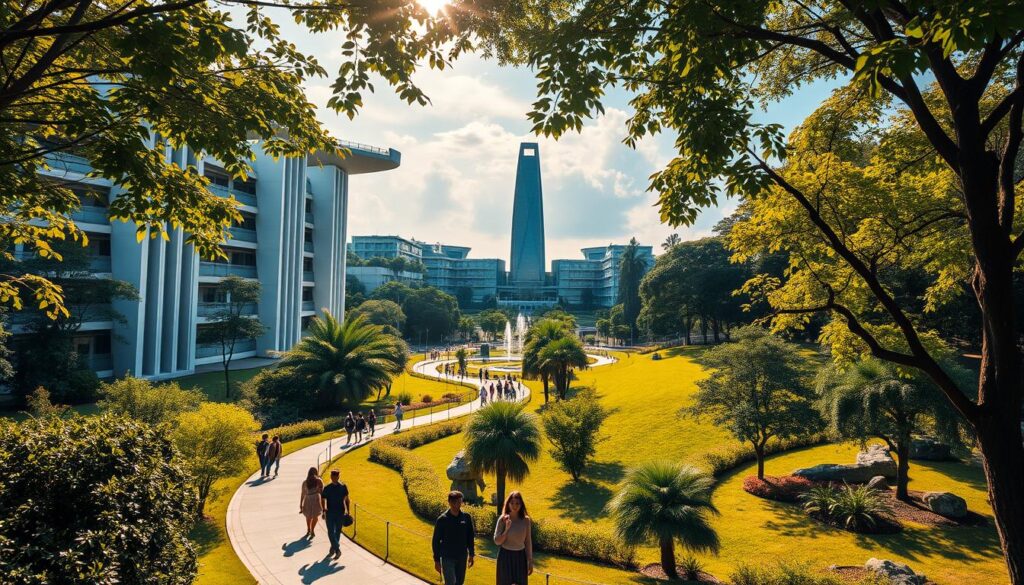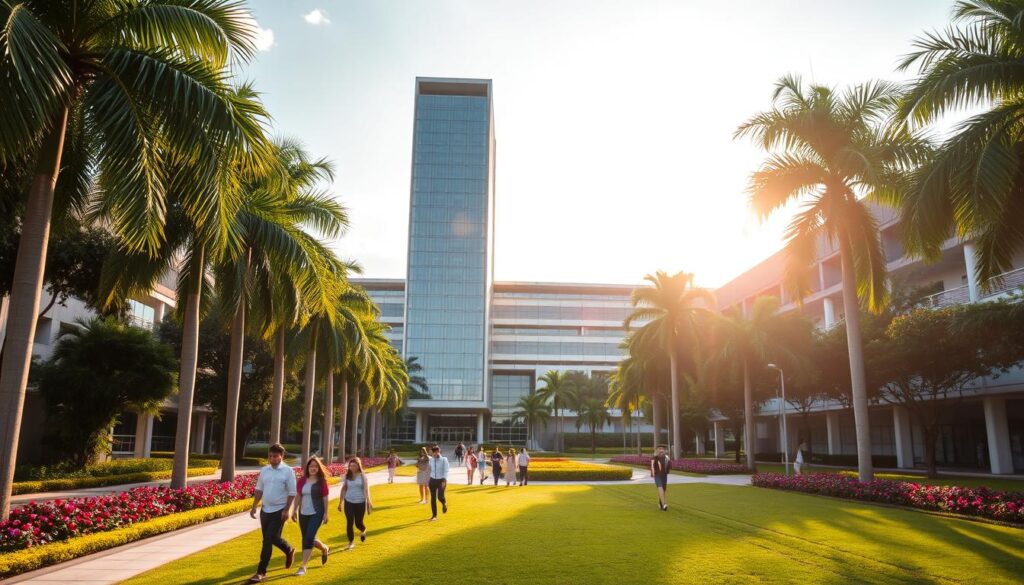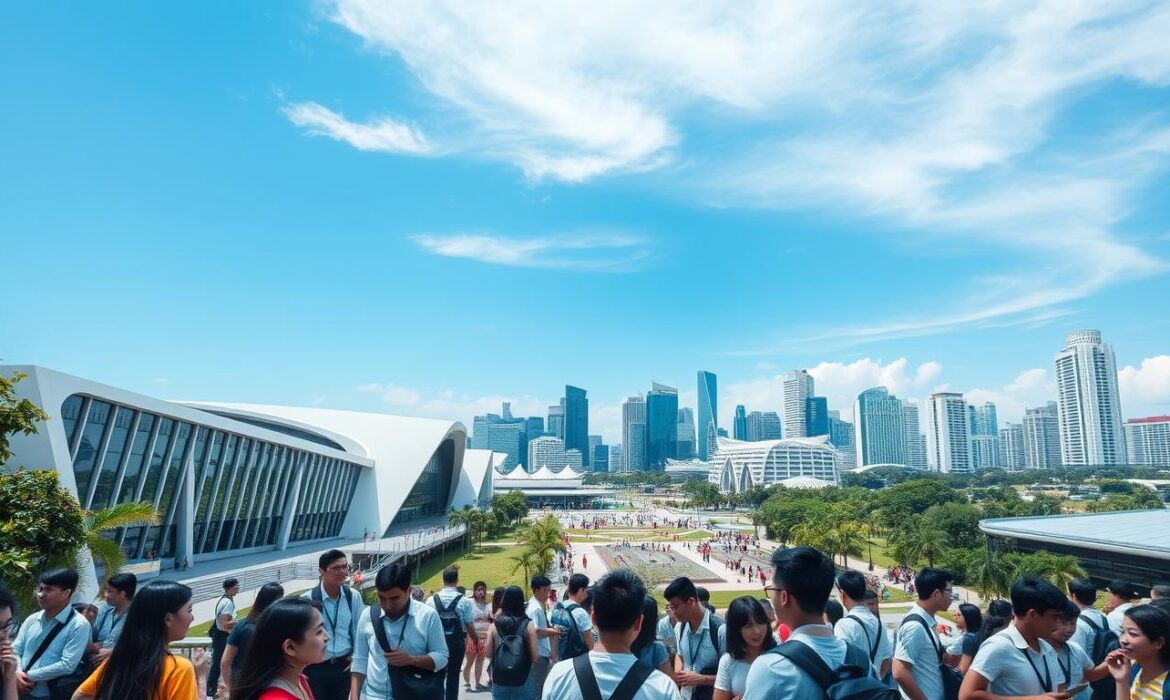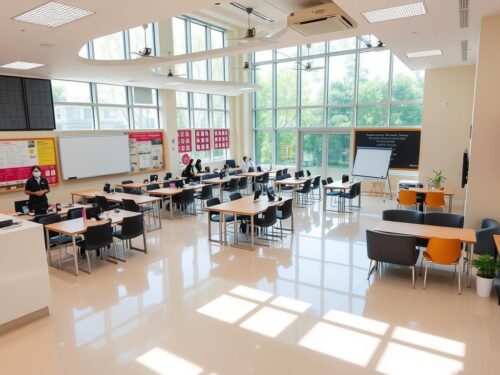Choosing the right institution for higher education is a crucial decision for students. In Singapore, polytechnics offer a wide range of courses that cater to diverse interests and career goals. This article provides a comprehensive comparison of the top five polytechnics, helping you make an informed choice.
We’ll explore key differences between institutions like Singapore Polytechnic, Ngee Ann, and Temasek. Factors such as course variety, campus facilities, and graduate outcomes play a significant role in rankings. Additionally, we’ll discuss the latest admission trends and program innovations for 2025.
Understanding these aspects can guide prospective students in selecting the right polytechnic. Whether you’re looking for specific courses or a vibrant campus life, this guide has you covered. Let’s dive into the details and find the perfect fit for your educational journey.
Key Takeaways
- Comprehensive comparison of top five polytechnics based on rankings and student reviews.
- Key differences between institutions like Singapore Polytechnic, Ngee Ann, and Temasek.
- Factors influencing rankings include course variety, campus facilities, and graduate outcomes.
- 2025 updates on admission trends and program innovations.
- Essential decision-making criteria for prospective students.
Introduction to Polytechnics in Singapore
Polytechnics offer a unique blend of practical learning and academic knowledge. These institutions focus on preparing students for the workforce through hands-on training and industry-specific skills. With a strong emphasis on project-based learning, polytechnics provide a dynamic educational experience.
What Are Polytechnics?
Polytechnics are practice-oriented tertiary institutions designed to equip students with real-world skills. They offer three-year diploma programs structured into two semesters per year. Students undergo four major exams annually, ensuring a rigorous academic journey.
These institutions emphasize internships, particularly in the final year. Students often work with industry leaders like OCBC, DBS, and EY. This exposure helps them gain valuable experience and build professional networks.
Why Choose a Polytechnic?
One of the key advantages of polytechnics is their focus on direct workforce entry. Graduates are equipped with industry-specific skills, making them job-ready. Additionally, polytechnic graduates often enjoy competitive starting salaries compared to their JC counterparts.
Government subsidies further reduce tuition fees, making education more accessible. This financial support ensures that students can focus on their studies without excessive financial burden.
| Aspect | Polytechnic | Junior College |
|---|---|---|
| Program Length | 3 years | 2 years |
| Focus | Practical skills | Academic theory |
| University Admission Rate | 17% | 75% |
Choosing a polytechnic can be a strategic decision for students aiming to enter the workforce quickly. With their focus on practical education and industry connections, these institutions provide a solid foundation for future success.
Polytechnic vs. Junior College: Which is Right for You?
Deciding between a polytechnic and a junior college can shape your future career path. Both options offer distinct advantages, but understanding their differences is key to making the right choice. Let’s explore the factors that can help you decide.
Program Length and Focus
Junior colleges typically offer a two-year program focused on academic theory. This prepares students for university entrance exams. In contrast, polytechnics provide a three-year program emphasizing hands-on training and practical skills.
If you prefer a more theoretical approach, a junior college might suit you. For those who thrive in applied learning environments, a polytechnic could be the better fit.
Stress Levels and Time Commitment
Junior college students often face high stress due to rigorous exam schedules. They spend an average of 40 hours per week studying. Polytechnic students, on the other hand, focus on project deadlines and spend about 25 hours per week on academic work.
Your ability to handle stress and manage time should influence your decision. Consider which environment aligns with your learning style.
Financial Considerations
Junior colleges are more affordable, with annual fees around $200. Polytechnics, however, cost about $3,000 per year. While this may seem steep, government subsidies can significantly reduce the financial burden.
It’s important to factor in hidden expenses like textbooks and transportation. Weigh the costs against the long-term benefits of your chosen path.
- Learning Style: Junior colleges focus on theory, while polytechnics emphasize practical skills.
- Career Goals: If you aim for university, a junior college might be better. For direct workforce entry, consider a polytechnic.
- Financial Planning: Assess your budget and explore available subsidies.
Ultimately, your choice should align with your career aspirations and personal preferences. Take time to evaluate your options and make an informed decision.
Understanding the Singapore Polytechnic System
Navigating the academic structure of polytechnics can help students plan their educational journey effectively. These institutions follow a well-organized system designed to balance rigorous learning with practical application. Let’s break down the key components of this system.
Academic Year and Semester Breakdown
The academic year in polytechnics typically runs from mid-April to mid-April. It is divided into two semesters, each with its own set of mid-term and final examinations. This structure ensures consistent progress and allows students to manage their workload effectively.
During these semesters, students engage in a mix of classroom lectures, hands-on projects, and internships. This combination fosters a holistic learning experience, preparing them for real-world challenges.
Examination and Grading System
Assessments in polytechnics vary by institution. For example, Singapore Polytechnic relies on traditional written exams, while Republic Polytechnic uses open-book digital examinations. These methods test both theoretical knowledge and practical application.
Grades are calculated using a GPA system, which considers both module credits and performance. Students must maintain a minimum GPA to avoid academic probation or expulsion. Failing multiple modules can lead to retakes or even course termination.
To support struggling students, polytechnics offer academic counseling, tutoring, and peer mentoring programs. These resources help students stay on track and achieve their goals.
- Semester Structure: Two semesters per year with mid-term and final exams.
- GPA Calculation: Based on module credits and performance.
- Assessment Methods: Written exams at SP, digital exams at RP.
- Academic Support: Counseling, tutoring, and peer mentoring.
- Consequences of Failure: Retakes or expulsion for multiple failures.
Understanding these aspects of the polytechnic system empowers students to make informed decisions and succeed in their academic pursuits.
Top Factors to Consider When Choosing a Polytechnic
Selecting the right polytechnic involves evaluating multiple factors to ensure it aligns with your goals. From the programs offered to the campus environment, each aspect plays a crucial role in shaping your educational experience. Let’s explore the key elements to keep in mind.
Course Offerings
The variety of courses available is one of the most important considerations. For instance, Singapore Polytechnic offers 37 programs across 11 schools, catering to diverse interests. If you’re looking for niche programs, Temasek Polytechnic’s law diplomas stand out as a unique option.
Evaluate the curriculum to ensure it aligns with your career aspirations. Look for programs that balance theoretical knowledge with practical application, as this prepares you for real-world challenges.
Location and Campus Facilities
The campus environment can greatly influence your learning experience. Ngee Ann Polytechnic boasts an Olympic-sized pool, while Republic Polytechnic features an adventure learning center. These facilities enhance both academic and extracurricular activities.
Consider transportation accessibility as well. A well-connected campus ensures you can focus on your studies without worrying about long commutes.
Internship and Industry Connections
Industry attachments are a cornerstone of polytechnic education, with 90% of students completing internships. Institutions like Ngee Ann and Nanyang Polytechnic have strong partnerships with companies such as Bosch and Resorts World, providing valuable opportunities for hands-on experience.
These connections not only enhance your skills but also help you build a professional network, giving you a head start in your career.
Ranking the Best Polytechnics in Singapore
Understanding how polytechnics rank can help students make informed decisions about their education. Rankings are based on factors like academic performance, specialty programs, and graduate outcomes. Let’s explore the criteria and see how the top institutions compare.
Criteria for Ranking
Rankings are determined by several key factors. These include admission cutoff points, graduate employment rates, and student satisfaction scores. Specialty programs like engineering or media studies also play a significant role.
For example, the 2025 Webometrics ranking placed Ngee Ann Polytechnic at the top. This reflects its strong performance in media studies and high graduate employment rates. Other institutions like Singapore Polytechnic excel in engineering, while Republic Polytechnic is known for its innovative Problem-Based Learning (PBL) system.
Overview of the Top 5 Polytechnics
Here’s a breakdown of the top institutions based on recent data:
| Institution | Cutoff Points (L1R4) | Specialty Strengths | Graduate Employment Rate |
|---|---|---|---|
| Singapore Polytechnic | 8-22 | Engineering | 92% |
| Ngee Ann Polytechnic | 8-26 | Media Studies | 90% |
| Republic Polytechnic | 10-24 | Sports Science | 88% |
| Nanyang Polytechnic | 9-25 | Information Technology | 89% |
| Temasek Polytechnic | 10-26 | Law Diplomas | 87% |
Recent student satisfaction surveys highlight the strengths of each institution. Singapore Polytechnic’s engineering programs are highly praised, while Ngee Ann Polytechnic’s media courses attract creative minds. Republic Polytechnic’s PBL system is particularly popular among sports enthusiasts.
By understanding these rankings and specialties, students can choose the institution that best aligns with their career goals and interests.
Singapore Polytechnic (SP): A Closer Look
Singapore Polytechnic stands as a cornerstone of practical education in the region. Established in 1954, it was the first institution of its kind, setting the standard for technical and vocational training. Over the years, it has built a reputation for excellence, producing notable alumni like Taufik Batisah, who have made significant contributions to their fields.

History and Reputation
As the pioneer of polytechnic education, SP has consistently been at the forefront of innovation. Its 38-hectare campus is equipped with state-of-the-art facilities, including Olympic-standard sports amenities. The institution’s commitment to industry-relevant education has earned it a strong reputation among employers and students alike.
Popular Courses and Facilities
SP offers a diverse range of programs, with Architecture and Business Administration being among the most sought-after. The curriculum is designed to blend theoretical knowledge with hands-on experience, preparing students for real-world challenges. Unique amenities like rock climbing walls and marine simulation labs further enhance the learning experience.
“The project-based learning approach at SP has been instrumental in shaping my career. It’s not just about textbooks; it’s about applying what you learn in real-world scenarios.” – SP Alumni
Student Life and Campus Culture
Life at SP is vibrant and engaging. The campus hosts frequent student camps, fostering a sense of community and collaboration. Extracurricular activities are a big part of the experience, with clubs and organizations catering to diverse interests. The campus culture encourages students to explore their passions while building lifelong friendships.
| Aspect | Details |
|---|---|
| Established | 1954 |
| Campus Size | 38 hectares |
| Notable Alumni | Taufik Batisah |
| Top Programs | Architecture, Business Administration |
| Unique Facilities | Rock climbing walls, marine simulation labs |
With its rich history, cutting-edge facilities, and vibrant student life, Singapore Polytechnic continues to be a top choice for students seeking a practical and enriching education.
Ngee Ann Polytechnic (NP): A Closer Look
Ngee Ann Polytechnic has established itself as a leader in creative and technical education. Founded in 1963, it offers 39 courses across various disciplines, with a strong emphasis on media and design. The institution’s innovative approach and industry partnerships make it a top choice for students seeking practical skills and career readiness.
History and Reputation
Since its inception, Ngee Ann Polytechnic has been at the forefront of education in the creative industries. Its reputation is built on a foundation of excellence, with notable alumni making significant contributions to fields like media and business. The institution’s $25M industry collaborations in 2024 further solidify its position as a leader in innovation.
Popular Courses and Facilities
NP is renowned for its Banking & Financial Services program, which prepares students for careers in finance. The institution also excels in design and film, offering state-of-the-art facilities like Studio27 and the Lifestyle Library. These resources provide students with hands-on experience, bridging the gap between education and industry.
“The film production facilities at NP gave me the tools to turn my passion into a career.” – Media Graduate
Student Life and Campus Culture
Life at NP is vibrant and engaging. The campus hosts a variety of extracurricular activities, from student clubs to industry events. Unique teaching partnerships, such as those with HBO Asia, offer students unparalleled opportunities to learn from industry leaders. This dynamic environment fosters creativity and collaboration, preparing students for success in their chosen fields.
- Signature Programs: Banking & Financial Services, Design, Film
- Campus Highlights: Studio27, Lifestyle Library
- Industry Collaborations: $25M partnerships in 2024
With its rich history, cutting-edge facilities, and strong industry connections, Ngee Ann Polytechnic continues to be a premier institution for students pursuing creative and technical careers.
Temasek Polytechnic (TP): A Closer Look
Temasek Polytechnic has carved a niche in the education landscape with its specialized programs. Established in 1990, it has grown into a leading institution known for its focus on applied sciences and creative disciplines. Its 30-hectare campus near Tampines hub offers students a modern and convenient learning environment.

History and Reputation
Since its founding, Temasek Polytechnic has been a pioneer in niche programs like legal studies. The institution’s commitment to innovation earned it the 2024 D&AD Award, highlighting its excellence in design and creative education. Its reputation is further bolstered by strong industry partnerships and a focus on real-world applications.
Popular Courses and Facilities
TP is renowned for its law and fashion design programs. The fashion design course boasts global partnerships, providing students with international exposure. The applied sciences departments are equally impressive, offering cutting-edge facilities that foster innovation and practical learning.
“The hands-on experience at TP prepared me for the challenges of the fashion industry.” – Fashion Design Graduate
Student Life and Campus Culture
Life at TP is vibrant and engaging. The east side location makes it accessible for residents, while the campus itself is equipped with modern amenities. Students can participate in various extracurricular activities, from design competitions to international events. Alumni achievements in global competitions further showcase the institution’s commitment to excellence.
| Aspect | Details |
|---|---|
| Established | 1990 |
| Campus Size | 30 hectares |
| Notable Programs | Law, Fashion Design, Applied Sciences |
| Awards | 2024 D&AD Award |
| Location | Near Tampines Hub |
With its specialized programs, innovative approach, and vibrant campus life, Temasek Polytechnic continues to be a top choice for students seeking a dynamic and practical education.
Nanyang Polytechnic (NYP): A Closer Look
Nanyang Polytechnic has become a hub for innovation and technology in education. Founded in 1992, it offers 40 IT-focused courses, making it a leader in tech education. Its distinctive white campus architecture is a symbol of modernity and creativity, attracting students from diverse backgrounds.
History and Reputation
Since its establishment, NYP has built a strong reputation for excellence. In 2024, it clinched the title of cybersecurity competition champions, showcasing its commitment to cutting-edge education. The institution’s focus on real-world applications and industry partnerships has made it a preferred choice for students aiming for tech careers.
Popular Courses and Facilities
NYP’s molecular biotechnology program boasts high success rates, preparing students for careers in science and research. The campus features unique amenities like the adventure challenge park, which promotes teamwork and leadership skills. Partnerships with tech giants like Google Cloud provide students with hands-on experience and industry insights.
“The hackathons at NYP gave me the confidence to tackle real-world tech challenges.” – NYP Student
Student Life and Campus Culture
Life at NYP is dynamic and engaging. Students participate in hackathons, workshops, and industry events, fostering creativity and collaboration. The white campus serves as a backdrop for a vibrant community where students explore their passions and build lifelong connections.
| Aspect | Details |
|---|---|
| Founded | 1992 |
| Specialty | IT-focused courses |
| Unique Feature | Adventure challenge park |
| Partnerships | Google Cloud |
With its innovative programs, state-of-the-art facilities, and vibrant student life, Nanyang Polytechnic continues to be a top choice for those seeking a future in technology and beyond.
Republic Polytechnic (RP): A Closer Look
Republic Polytechnic stands out for its innovative approach to education and modern campus facilities. Established in 2002, it was the first institution in Singapore to adopt a paperless policy, reflecting its commitment to sustainability and technology. With a 20-hectare fully air-conditioned campus, RP offers a comfortable and forward-thinking learning environment.

History and Reputation
Since its founding, RP has been a pioneer in education, particularly with its Problem-Based Learning (PBL) system. This unique approach encourages students to solve real-world problems, fostering critical thinking and collaboration. The institution’s reputation is further enhanced by its partnerships with industry leaders like ActiveSG in its sport management program.
Popular Courses and Facilities
RP offers a range of programs, with aviation management and sport management being particularly popular. The aviation program collaborates with industry giants, providing students with hands-on experience. The campus boasts state-of-the-art facilities, including a martial arts studio and a swimming complex, which support both academic and extracurricular activities.
“The PBL system at RP helped me develop problem-solving skills that are invaluable in my career.” – RP Alumni
Student Life and Campus Culture
Life at RP is dynamic and engaging. The institution’s digital-first approach means assignments and resources are accessible online, making learning more flexible. Students also participate in outdoor education programs, which promote teamwork and leadership. The campus culture is vibrant, with numerous clubs and events that cater to diverse interests.
| Aspect | Details |
|---|---|
| Established | 2002 |
| Campus Size | 20 hectares |
| Unique Feature | Paperless policy |
| Popular Programs | Aviation Management, Sport Management |
| Facilities | Martial arts studio, swimming complex |
With its innovative teaching methods, modern facilities, and vibrant student life, Republic Polytechnic continues to be a top choice for students seeking a forward-thinking education.
What Makes the Best Poly in Singapore?
Finding the right educational path can shape your future in meaningful ways. With so many options available, it’s essential to evaluate what truly matters. From graduate employability to campus culture, several factors can influence your decision.
Key Factors to Consider
When comparing institutions, graduate employability is a top priority. For example, Ngee Ann Polytechnic boasts a 92% recommendation rate from its students. Industry links also play a crucial role, as they provide students with real-world experience and networking opportunities.
Student satisfaction is another important metric. Singapore Polytechnic maintains an impressive 4.3/5 average graduate satisfaction score. Alumni networks are equally valuable, offering mentorship and career guidance long after graduation.
Hidden gems like Republic Polytechnic’s entrepreneurship programs add unique value. These initiatives encourage innovation and prepare students for the challenges of the modern workforce.
Student Testimonials and Reviews
Hearing from current and former students can provide valuable insights. Here’s what some have to say:
“The hands-on projects at Ngee Ann Polytechnic gave me the confidence to excel in my career.” – Media Studies Graduate
“The supportive community at Singapore Polytechnic made my journey unforgettable.” – Engineering Alumni
These reviews highlight the diverse experiences students can expect. Whether it’s the vibrant campus life or the practical learning approach, each institution offers something unique.
- Graduate Employability: Look for institutions with strong industry connections.
- Student Satisfaction: Compare feedback across different faculties.
- Alumni Networks: Seek institutions with active and supportive alumni communities.
- Hidden Gems: Explore niche programs that align with your interests.
By considering these factors, you can make an informed choice that aligns with your goals and aspirations.
Choosing the Right Polytechnic for Your Career Goals
Your career goals should guide your choice of polytechnic education. With so many programs available, it’s essential to pick one that aligns with your aspirations. Whether you’re aiming for tech, media, or engineering, the right course can set you on a successful path.

Aligning Courses with Career Aspirations
Polytechnics offer a wide range of programs tailored to different industries. For example, Nanyang Polytechnic’s IT courses have placed students in top companies like Grab and Shopee. These programs are designed to meet the demands of emerging industries, ensuring graduates are job-ready.
When choosing a course, consider your long-term career objectives. Look for programs that combine theoretical knowledge with practical skills. This balance prepares you for real-world challenges and increases your employability.
Industry Partnerships and Internship Opportunities
Industry collaborations are a cornerstone of polytechnic education. Institutions like Ngee Ann Polytechnic have strong ties with companies such as HBO Asia, providing students with valuable opportunities. These partnerships often lead to internships, where students gain hands-on experience.
Did you know that 80% of poly interns receive job offers? This highlights the importance of internships in bridging the gap between education and work. Programs with guaranteed internships give students a head start in their chosen fields.
- Emerging Industries: Map popular courses to sectors like tech and media.
- Internship Programs: Seek institutions with guaranteed placements.
- Salary Benchmarks: Research earning potential by discipline.
- Corporate Partnerships: Highlight exclusive collaborations with industry leaders.
- Success Stories: Share case studies of graduates who transitioned successfully.
By aligning your education with your industry interests, you can build a strong foundation for your future. Explore more about top polytechnic programs to make an informed decision.
Life as a Polytechnic Student in Singapore
Balancing academics and extracurriculars is a key part of the polytechnic experience. With an average of 25 contact hours per week, students juggle lectures, projects, and co-curricular activities (CCAs). This dynamic lifestyle prepares them for both professional and personal growth.
Academic Expectations
Polytechnic students typically follow a structured daily schedule. Mornings are often dedicated to lectures, while afternoons may involve hands-on projects or group discussions. Time management is crucial, especially when balancing coursework with CCAs.
Leadership development programs are also a significant part of the campus culture. These initiatives help students build essential skills like teamwork and problem-solving, which are invaluable in their future careers.
Extracurricular Activities and Student Organizations
With over 150 student clubs across all polytechnics, there’s something for everyone. Unique organizations like Singapore Polytechnic’s marine conservation club offer students the chance to explore their passions while making a difference.
Annual events, such as Ngee Ann Polytechnic’s film festival, are highlights of the student life. These gatherings foster creativity and provide platforms for students to showcase their talents.
“Joining the film club at NP was one of the best decisions I made. It helped me grow both personally and professionally.” – Film Club Member
Here are some tips for managing your workload effectively:
- Prioritize tasks: Focus on deadlines and important assignments first.
- Stay organized: Use planners or apps to track your schedule.
- Take breaks: Short breaks can boost productivity and reduce stress.
Whether you’re into sports, arts, or community service, polytechnics offer countless opportunities to enrich your experience. Embrace the journey and make the most of your time on campus.
Financial Aid and Scholarships for Polytechnic Students
Pursuing higher education often comes with financial challenges, but there are numerous options to ease the burden. From government grants to corporate scholarships, students can access various forms of financial aid to support their studies. Understanding these opportunities can make a significant difference in managing tuition and other expenses.
Available Financial Support
The MOE Tuition Grant is a key resource, covering 50-80% of tuition fees for eligible students. This grant ensures that education remains affordable for many. Additionally, there are over 200 scholarship options available, ranging from government-funded programs to private and corporate awards.
Here’s a breakdown of some popular financial support options:
- Government Subsidies: MOE Tuition Grant, bursaries for low-income families.
- Corporate Scholarships: DBS Business Scholarship, OCBC Local Undergraduate Scholarship.
- Institutional Awards: Merit-based scholarships offered by individual polytechnics.
Hidden costs like lab fees and material expenses can add up. It’s essential to factor these into your budget when planning your education.
How to Apply for Scholarships
Applying for scholarships can seem daunting, but breaking it down into steps makes it manageable. Start by researching available opportunities and their eligibility criteria. Prepare all required documents, such as academic transcripts and recommendation letters.
Follow this step-by-step guide to streamline the process:
- Identify scholarships that align with your academic achievements and career goals.
- Gather necessary documents, including proof of income and personal statements.
- Submit your application before the deadline, ensuring all details are accurate.
- Prepare for interviews or additional assessments if required.
Many students have successfully secured scholarships, paving the way for their academic and professional success. For example, a recent recipient of the DBS Business Scholarship shared how it allowed her to focus on her studies without financial stress.
| Type of Support | Coverage | Eligibility |
|---|---|---|
| MOE Tuition Grant | 50-80% of fees | All students |
| DBS Business Scholarship | Full tuition + stipend | Business students |
| Polytechnic Bursaries | Up to $1,000 | Low-income families |
By exploring these financial aid options and following the application process, students can focus on their education and future goals. Whether through grants or scholarships, there’s ample support available to help you succeed.
Future Prospects After Graduating from a Polytechnic
Graduating from a polytechnic opens doors to diverse opportunities, both academically and professionally. Whether you aim to further your education or enter the workforce, polytechnic graduates are well-equipped to succeed. Let’s explore the paths available after completing your diploma.
University Admissions
About 35% of poly graduates choose to pursue degrees at local or overseas institutions. Many polytechnics have articulation programs with universities, allowing students to seamlessly transition into degree courses. For example, Singapore Polytechnic partners with NUS and NTU, offering advanced standing for certain programs.
Overseas university partnerships are also common. Institutions like Ngee Ann Polytechnic collaborate with universities in the UK and Australia, providing students with global exposure. These partnerships often include credit transfers, reducing the time and cost of obtaining a degree.
Career Opportunities and Job Market
Polytechnic graduates enjoy strong employment prospects, with an average starting salary of $2,800/month. Employment rates vary by course cluster, with IT and engineering graduates often securing jobs quickly. Fast-growing industries like cybersecurity and renewable energy are actively hiring poly graduates.
Here’s a breakdown of career progression paths compared to JC peers:
- Career readiness: Polytechnic graduates often enter the workforce sooner, equipped with practical skills.
- Salary growth: Many poly graduates see significant salary increases within five years of work experience.
- Industry demand: Sectors like tech and healthcare offer abundant opportunities for poly graduates.
Whether you choose to continue your education or start your career, polytechnic graduates are well-positioned for success. By leveraging the skills and knowledge gained during your studies, you can confidently navigate your future path.
Conclusion: Making the Right Choice for Your Education
Your educational journey is a stepping stone to a bright future, and selecting the right institution is a pivotal step. Each polytechnic offers unique strengths, from specialized programs to industry partnerships. Aligning your course with your career goals ensures you gain the skills needed for success.
Visiting campuses and attending open houses can provide valuable insights. These experiences help you gauge the environment and facilities, making your decision easier. Take notes, ask questions, and envision yourself thriving in that setting.
Here’s a quick checklist to guide your choice: research course offerings, evaluate industry connections, and consider campus culture. These factors will help you make an informed and confident decision.
Remember, your education is an investment in your future. With dedication and the right choice, you’ll be well-prepared to achieve your goals and make a meaningful impact in your chosen field.



